The Long Game Improvement Plan – Part 3
In this part of the long game improvement plan we’re going to look at the transition, downswing and impact. And we’ll start by looking at…
The Transition
The transition is the START of you finding amazing power in your golf swing that you never thought existed or was even possible! And this amazing power will come with much greater accuracy too when you master the transition.
Now hearing this may give you the impression that the backswing is of little value, but that could not be further from the truth.
If that was true you’d have golfers simply setting up to a ball, lifting the club up and positioning it perfectly at the top of the backswing, and swinging down from this perfect top of the backswing position. Of course that doesn’t happen and never will.
Because it’s the transition from the backswing to the downswing where the majority of the power in the golf swing comes from. And the better your backswing is the easier it is to make a great transition to the downswing — giving you more power and accuracy!
You see, the backswing sets the stage for the transition.
And what separates the great ball strikers from the average ones is the quality of the transition. So if you want to become a great ball striker this is one aspect of your golf swing that you’re going to have to really spend some time practicing. But remember, the pay off for doing this is huge i.e….
Longer and More Accurate Golf Shots!
Now like everything where only a small percentage are successful, the great ball strikers have spent a lot of practice time perfecting their transition from backswing to downswing. And to be completely honest with you, the transition is the hardest move in the golf swing to perfect. The reason for this is obvious.
During your swing, for a brief second your upper body should be completing the backswing while your lower body is starting to move towards the target. So to complete the transition successfully you should have two main segments of your body (upper and lower) going in different directions.
I know that sounds hard….and that’s because it is!
But it’s doable and as a student of mine I show you how to do it. And when you “get it” you’re going to get so much more enjoyment from this game due to the extra distance and accuracy you’ll gain…you’re going to love it!
So if you wanted to throw a golf ball as far as you possibly could down the fairway would you?:
- a) shift your weight to your back foot as you’re taking the ball back and then shift the weight to your front foot to throw the ball, or
- b) keep your weight evenly distributed the entire time you’re throwing the ball.
I hope you picked A because that’s what any athlete would do to throw a ball as far and fast as possible. Just take a look at a baseball pitcher for example. When they pitch they move their weight to the back foot. And they do this so much so that when they’re taking the ball back they lift their front foot up.
Then to change directions they shift their weight aggressively to their front foot and keep moving all of their weight so that at the end of the pitch basically all of their weight is on their front foot.
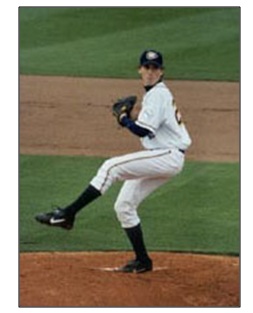
That’s an example of a powerful transition and one that you’d do well to model in your golf swing.
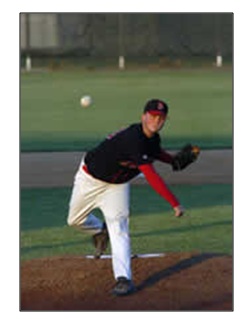
Now a lot of golfers suffer from an overly steep downswing. Which is sad, real sad, because that’s one of the biggest causes of a slice. But to avoid this, when you’re changing directions from your backswing to your downswing your club should move to the left instead of coming straight down.This is one of the toughest moves in the transition for a golfer to perfect.
Why?
Because it’s generally the complete opposite of what a golfer has done their entire golfing lives. But once you learn and perfect this move it will make a HUGE difference to your golf swing, because this move is what really separates a great ball striker from an average one as it’s the complete opposite of what an average ball striker generally does.
The Downswing
You can see how good a golfer has transitioned into the downswing by looking at a golfer’s swing at one specific point in the downswing. That point is when the left arm is parallel with the ground.
When looking at a downswing of my online students there are two major things I look for. The first is the angle formed with the left arm and club. It should be at 45 degrees or less like this…
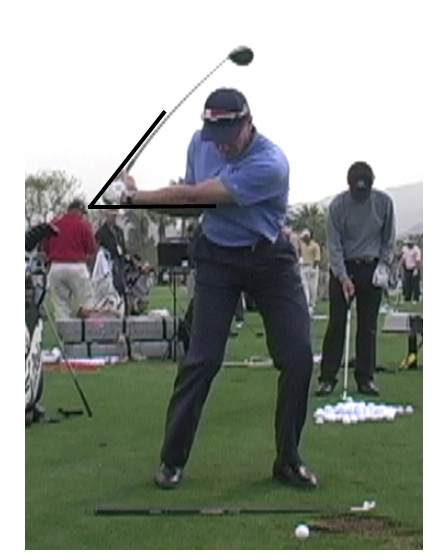
Why?
Well, ever heard of the term….”a late release”?
Whether you’ve heard of it or not I want to clarify exactly what it is just so we’re on the same page, so to speak. A late release is the term used to describe the angle between your left arm and club shaft in the downswing. And the less angle you have at this point the better. Because having a late release will help you to generate more clubhead speed and hit the ball further which I’m sure you’d enjoy.
Next, when I’m analyzing a golfer’s transition and downswing I look down the line at a golfer’s swing at the half way point. At that point you can clearly see how good that golfer’s swing is as far as direction and accuracy is concerned. When the left arm is parallel with the ground the club shaft should be angled so that it’s either pointing at the ball or to the right of the ball like this….
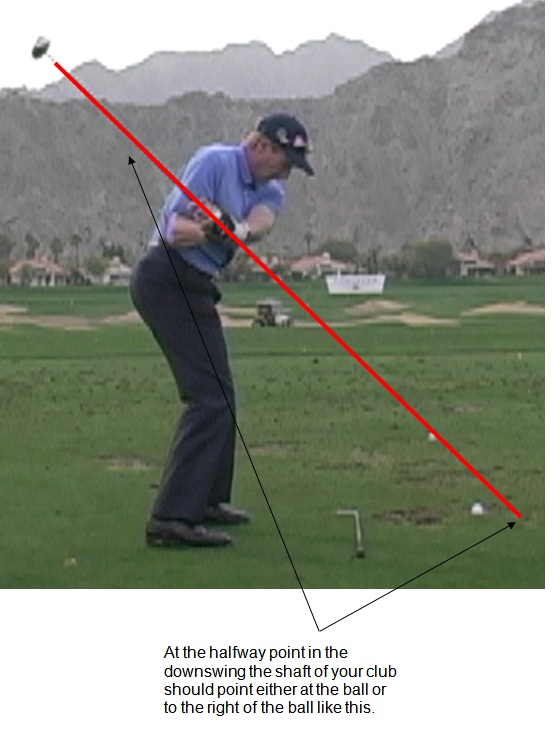
Now I want to discuss something that is very important and very misunderstood in the golf swing. But before I do that here’s a quote from quite a good golfer :-)…
“As far as applying power goes, I wish that I had three right hands!”
Ben Hogan
Did you read that quote above?
I hope so because it’s very important. Now don’t get me (or Ben Hogan) wrong, I don’t think that golf is a right sided game. Because during the golf swing your right hand plays an important role and so does your left. And for you to become a great consistent ball striker you can’t focus on one hand more than the other.
But the reason Ben Hogan wished for three right hands is because he found out that the right side is the power side in the golf swing. Because when you start your downswing your lower body moves toward the target and your right side moves aggressively down to the ball (more aggressively than your left).
And it’s very clear to see the big influence the right side has on the golf swing when you look at a good golf swing from side on. At the half way point in the downswing the right arm should be visible under your left. A position in the golf swing like this can only be achieved if the right side is working more aggressively than the left side.
However, a lot of golfers have been taught to subdue their right side, which is wrong!
You want to aggressively swing down into the ball with your right side so you get the most power and distance possible. But…and this is important: doing that is only going to be of benefit to you if you combine it with what the left hand should be doing.
You see, it’s all about team work!
Because you can’t hit good consistent shots while having one hand dominating the swing.
OK, let’s now look at what should be happening at…
Impact
The position you arrive at impact in is the result of all the positions that went before. You can’t contrive a great impact position. Having said that, there are great golfers that have far less than perfect swing mechanics that arrive at a great impact position.
How does that happen?
Compensations and manipulations.
They have hit so many balls, learned from trial and error and have great hand-eye coordination, that they can consistently do things with the golf club during the swing that causes them to arrive at the ball in a great impact position, i.e. Lee Trevino, Ray Floyd etc.
And if you look at all great ball strikers at the moment of impact they are all in a very similar position, no matter what they’ve done to get there.
Now before I tell you what should be happening at impact I want to clear up something very important about the impact position. And that is this:
Important Note: When you arrive at the impact position you should NOT be in the same position as you were in at address.
A lot of golf teachers teach this but if you look at all the top ball strikers at impact this simply does not happen. For example….
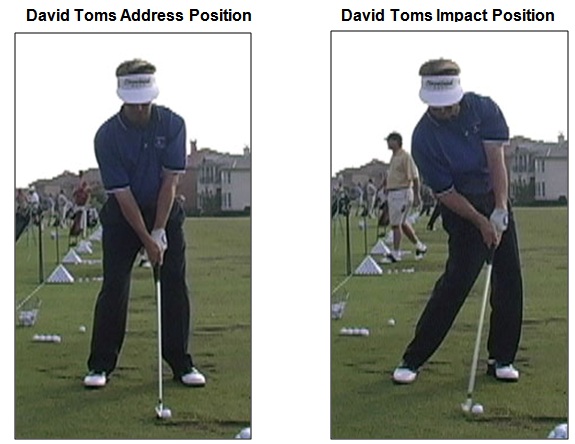
So the first thing we’re going to have a look at in regards to impact is the hands, and more specifically your left hand. In the 1956 April edition of Golf Digest Ben Hogan wrote this:
“I’ve noticed one thing that all good golfers do and all bad golfers do not. The good ones have their left wrist leading at impact. It seems a small thing, but I’ve found it to be universally true. At impact the left wrist of a good player is slightly convex, while that of a poor player is generally concave.”
Ben Hogan
And a few minutes ago I said that you should not be in a position at impact that is similar to what you were in at address.
Remember?
Well, one part of your body that should definitely not be anywhere close to the position it was at address is your hands. Because at impact your left hand should be convex slightly (bent slightly towards the target) and your hands should be quite a bit in front of where they were at address (look at those David Toms pictures for confirmation of this). This should happen naturally when you swing, because your hips move well in front of where they were at address due to the great lower body movement during the downswing.
But sadly a lot of golfers interfere with this natural action, and instead they try to scoop the ball to help it get up in the air. The result of this is a left hand at impact that is concave. This very weak position with the left hand results in golf shots that lack accuracy, power and penetration.
Important Note: If most of your irons go much the same distances, e.g. a 5 iron going much the same distance as a 7 iron etc. the reason will be because at impact your left hand is concave.
Now remember when I said that right hand is the power hand. Well it is, but the left hand is the lead hand and it must control the power applied by your right hand.
You can’t let your right hand lead the downswing. It must power it but the left hand should always lead it. And when you’re a student of mine and learn to hit the ball with your left hand in the position of being convex at impact you’ll hit shots with a lot more power and a much better flight trajectory that will add distance to your shots. Not to mention, much greater accuracy too!
Now at impact your right heel should be up off the ground. This is a result of most of your weight (about 90%) being transferred to your left side during the transition and downswing.
Also, both of your knees should drive towards the target to help the lower body get through the shot with the most power possible. Because of all of this your hips should be about 6 inches in front of where they were at setup, and open by about 45 degrees to the target at impact.
Now listen up to what I have to say next because this is very important.
Even though your hips should move well towards the target and they should be very open, your head should be in pretty much the same position it was at address. You should not allow your head to move towards the target until well after impact.
By doing this it means your lower body is well in front of your upper body which is just the way it should be. And the reason you want your lower body to make such an aggressive move towards the target and then to open up is to clear the lower body out of the way — especially the hips, to allow the shoulders and arms a lot of room to swing down forcefully to impact and into the follow-through.
OK, we’ve covered a lot of detail so here is a pictorial summary of what should be happening at impact from head to toe:
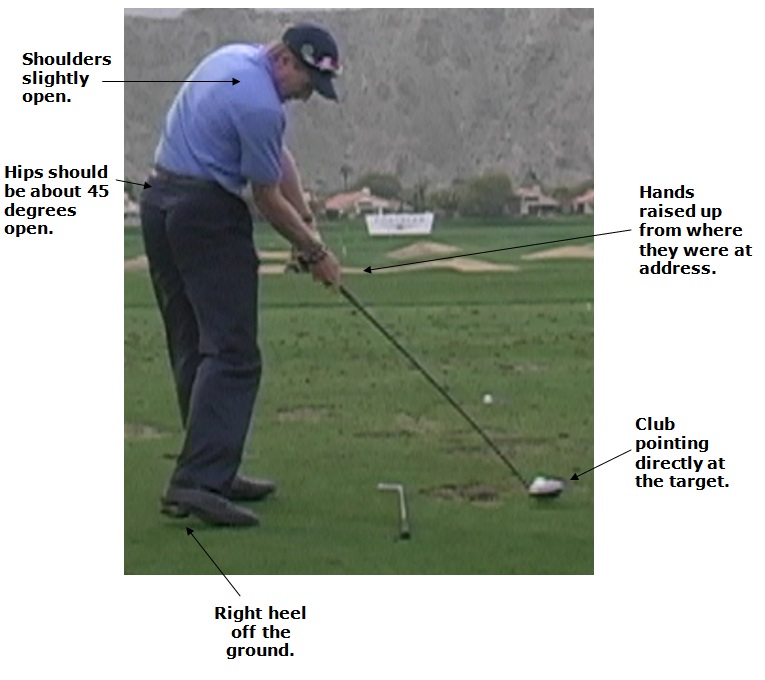
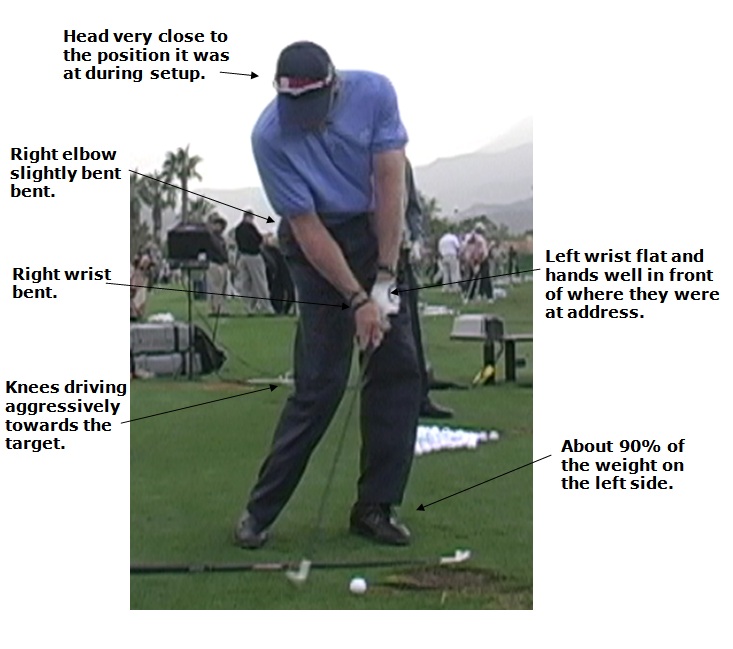
1.Weight Transfer/Hip Slide/Rotation: At impact about 90% of your weight should be on your left side and you hips should be open by about 45 degrees to the target. Also, at impact your hips should be about 6 inches in front of where they were at impact.
2.Shoulders: At impact your shoulders should be slightly open.
3. Head: At impact your head should be in a position very close to the one it was in during setup.
4. Late Release: When your left arm is parallel with the ground the shaft and your left arm should form about a 45 degree angle (or less).
5. Hands: At impact your hands should be well in front of where they were at impact and your left hand must be flat and your right wrist must be flexed.
6. Shaft Plane: At the halfway point in your downswing your shaft should be pointing at the ball or to the right of it.
So that’s the six most important aspects of the transition, downswing and impact. Get them right and everything else will almost certainly fall into place.
That concludes Part 3 of this long game improvement plan. In Part 4 of this plan we’re going to look at the follow-through and the finish of the golf swing. There’s some very important information I share there. So look out for my next post.

